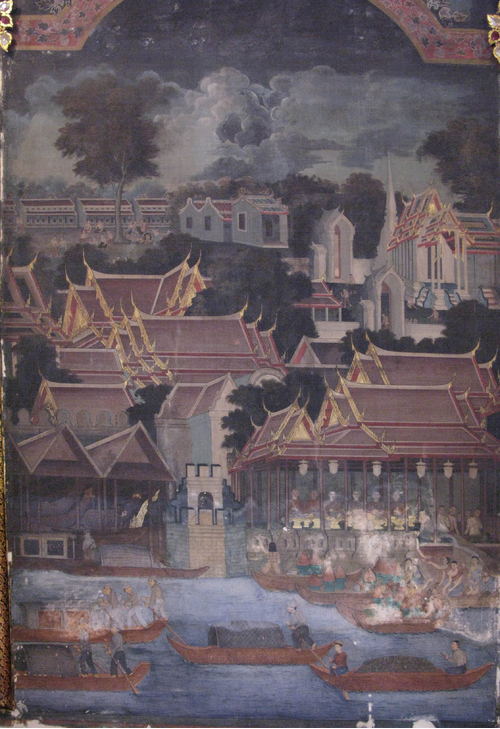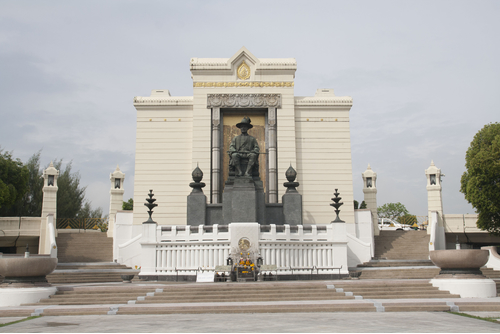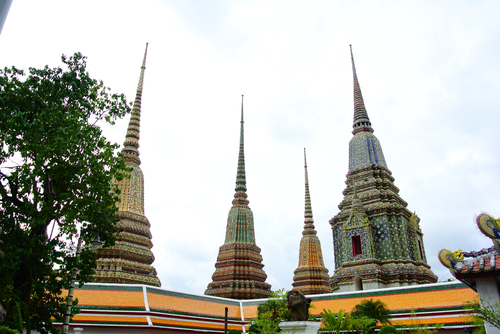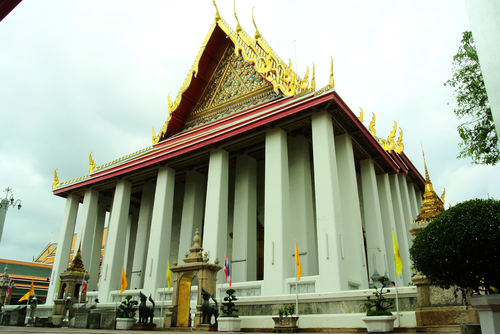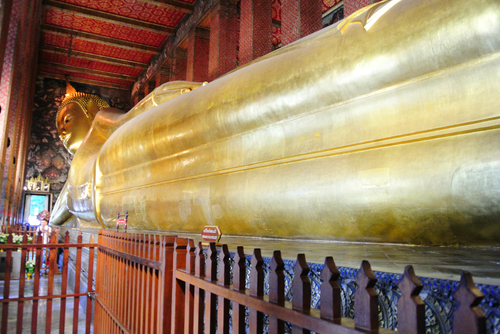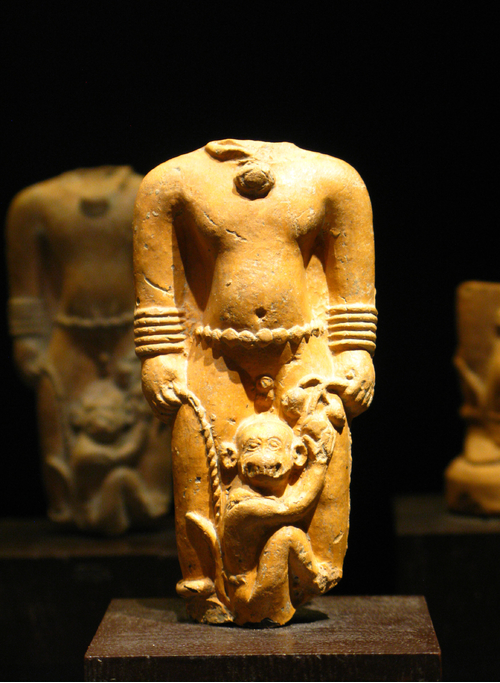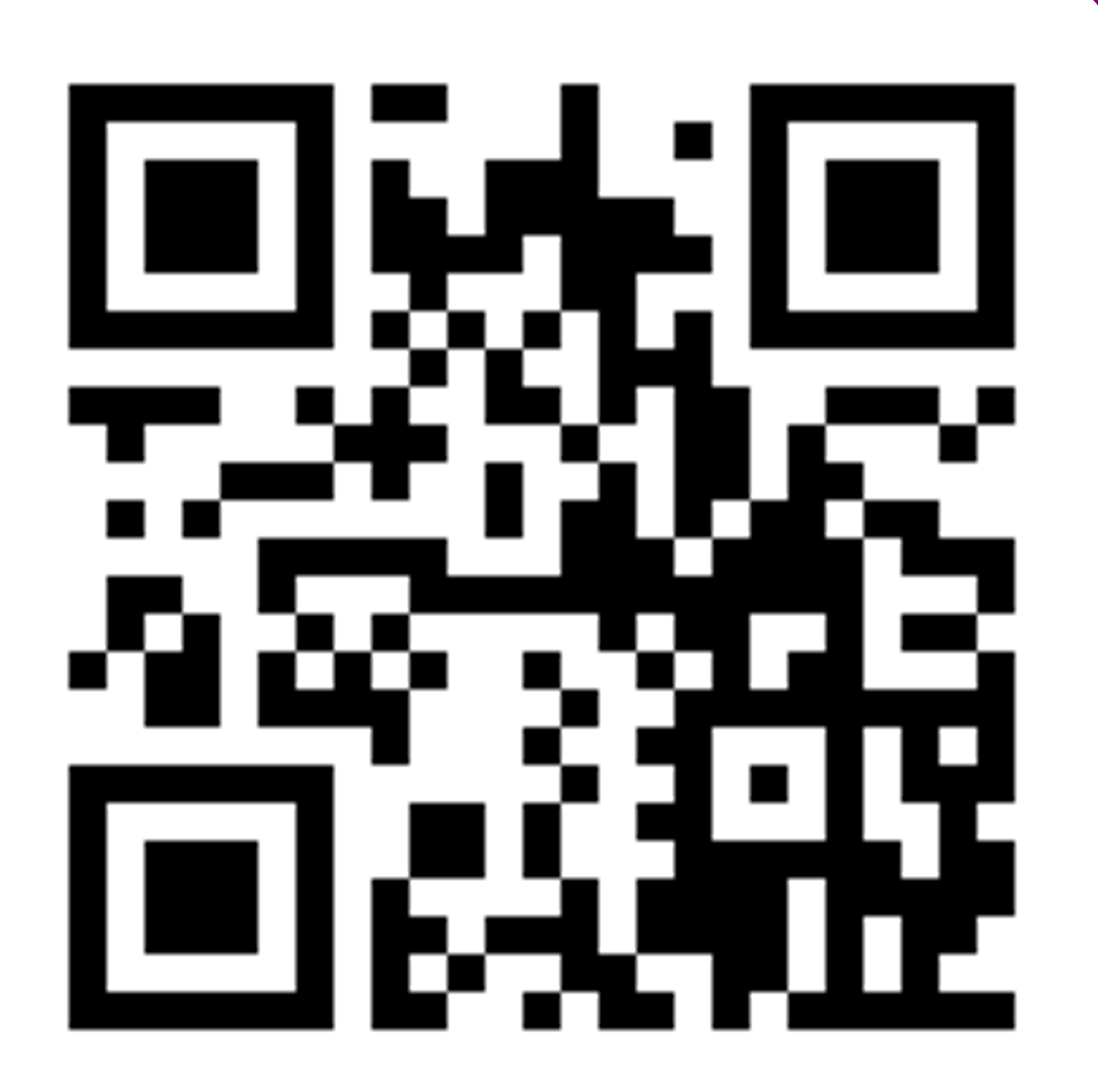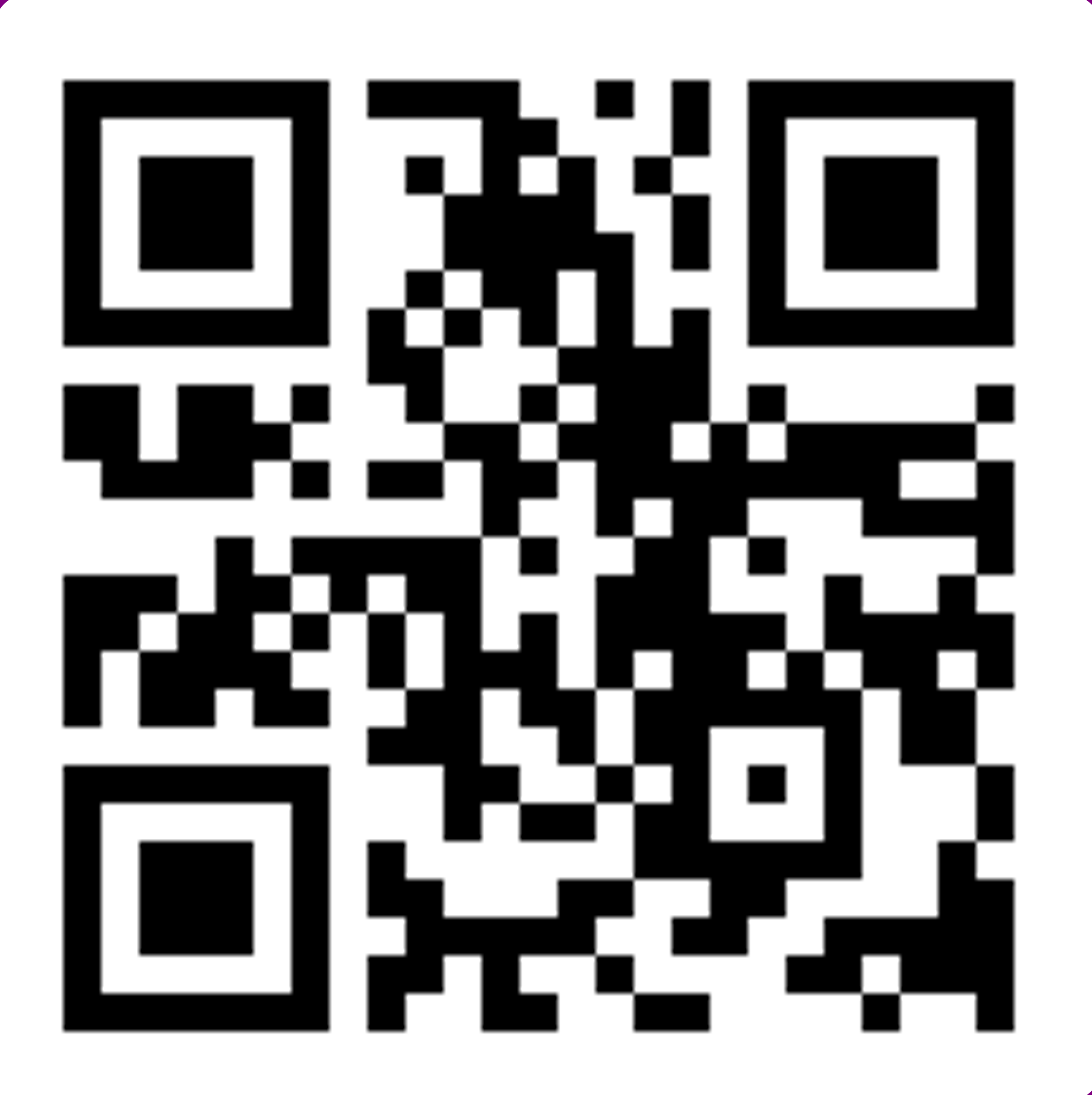ค้นหางานศิลปกรรม
ฐานข้อมูลศิลปกรรมในเอเชียตะวันออกเฉียงใต้
จิตรกรรมจิตรกรรมเรื่องพระราชพิธีสิบสองเดือน
ภาพพระราชพิธีในแต่ละเดือนเขียนขึ้นที่ผนังระหว่างช่องหน้าต่าง โดยปรากฏอิทธิพลการเขียนภาพแบบตะวันตกแล้ว กล่าวคือ มีการใช้เส้นขอบฟ้า กำหนดมิติของภาพให้เกิดระยะที่ใกล้-ไกล ภาพทิวทัศน์ เช่น ท้องฟ้า ก้อนเมฆ ต้นไม้เขียนขึ้นโดยคำนึงถึงความสมจริง ภาพอาคารสถานที่ซึ่งเป็นสถานที่ประกอบพระราชพิธีมักเป็นพระมหาปราสาทและอาคารต่างๆที่มีอยู่จริงในพระบรมมหาราชวังและพื้นที่ใกล้เคียง เช่น บริเวณท่าราชวรดิษฐ์ที่ประกอบด้วยป้อมและหมู่พระที่นั่งต่างๆ ซึ่งปัจจุบันไม่เหลือหลักฐานแล้ว ภาพการโล้ชิงช้าที่เสาชิงช้าหน้าโบสถ์พราหมณ์ เป็นต้น ภาพบุคคลแต่งกายตามสถานภาพ มีทั้งที่เป็นทหารใส่เครื่องแบบที่พัฒนาการตะวันตก ภาพชาววังและชาวบ้านที่แต่งกายตามสมัยนิยม รวมทั้งชาวต่างชาติที่มีอยู่ในสังคมขณะนั้น การลงสีมีการแรเงา ไล่น้ำหนักสีอ่อนแก่ ภาพบุคคลมีขนาดเล็กเมือเทียบกับภาพสถาปัตยกรรม มีความพยายามเขียนภาพเหมือนบุคคลขนาดเล็กด้วย
สถาปัตยกรรมอนุสาวรีย์ประชาธิปไตย
อนุสาวรีย์ประชาธิปไตยเป็นประติมากรรมลอยตัว สิ่งสำคัญคือ รัฐธรรมนูญซึ่งมีลักษณะเป็นสมุดไทยประดิษฐานบนพานแว่นฟ้า สร้างด้วยทองแดง มีความสูง 3 เมตร หนัก 4 ตัน ตั้งบนฐานรูปทรงกลมด้านบนโค้งกลม ลานอนุสาวรีย์ยกสูงมีบันไดโดยรอบ รอบนอกลานอนุสาวรีย์มีครีบทรงแบน อยู่ 4 ทิศ ที่โคนครีบ มีภาพปูนปั้นนูนต่ำ และมีรั้วเตี้ย ๆ กั้นโดยรอบลานอนุสาวรีย์ รั้วนี้ใช้ปืนใหญ่โบราณจำนวน 75 กระบอก ฝังดินโผล่ท้ายกระบอกขึ้นมาเป็นเสาแล้วคล้องโซ่เชื่อมต่อกัน โดยองค์ประกอบต่างๆของอนุสาวรีย์มีความหมายดังนี้ 1.ครีบ 4 ด้าน สูงจากแท่นพื้น 24 เมตร มีรัศมียาว 24 เมตร หมายถึง วันที่ 24 ซึ่งเป็นวันเปลี่ยนแปลงการปกครอง 2.พานทูนฉบับรัฐธรรมนูญ ซึ่งตั้งอยู่บนยอดป้อม กลางตัวอนุสาวรีย์ สูง 3 เมตร หมายถึง เดือน 3 หรือ เดือนมิถุนายน (ขณะนั้นนับเมษายนเป็นเดือนแรกของปี) ตรงกับเดือนที่มีการเปลี่ยนแปลงการปกครองสมัยนั้น และหมายถึง อำนาจอธิปไตยทั้ง 3 ภายใต้รัฐธรรมนูญ (นิติบัญญัติ บริหาร และตุลาการ) 3.ปืนใหญ่ที่มีปากกระบอกฝังลงในพื้นดินจำนวน 75 กระบอก รอบฐานของอนุสาวรีย์ที่มีโซ่เหล็กคล้องไว้ หมายถึง พ.ศ.2475 ที่มีการเปลี่ยนแปลงการปกครอง ส่วนโซ่ที่คล้องไว้ด้วยกันหมายถึงความสามัคคีพร้อมเพรียงของคณะปฏิวัติ 4.ลายปูนปั้นนูนต่ำที่ฐานครีบทั้ง 4 เน้นถึงเรื่องราวการดำเนินงานของคณะราษฎรตอนที่นัดหมายและแยกย้ายกันก่อการเปลี่ยนแปลงการปกครอง เมื่อวันที่ 24 มิถุนายน พ.ศ. 2475 5.พระขรรค์ 6 เล่ม ที่รายล้อมรอบป้อมกลางตัวอนุสาวรีย์ หมายถึง หลัก 6 ประการของคณะราษฎร อ่างตรงฐานปีกทั้ง 4 ด้านเป็นรูปงูใหญ่ หมายถึง ปีมะโรงซึ่งเป็นปีที่เปลี่ยนแปลงการปกครอง
สถาปัตยกรรมพระปฐมบรมราชานุสรณ์
พระบรมรูปพระบาทสมเด็จพระพุทธยอดฟ้าจุฬาโลกมหาราช หรือพระปฐมบรมราชานุสรณ์เป็นพระบรมรูปประทับนั่งเหนือพระราชบัลลังก์ ผินพระพักตร์มาทางด้านถนนตรีเพชร ทรงเครื่องบรมขัตติยราชภูษิตาภรณ์ ทรงพระมาลา ทอดพระหัตถ์บนพระแสงดาบที่อยู่เหนือพระเพลา มีฐานหินอ่อนเป็นที่รองรับพระบรมรูปหล่ออีกชั้นหนึ่ง เบื้องหลังก่อเป็นกำแพงหินอ่อนกั้นตอนกลางเจาะเป็นช่องลึกคล้ายประตู มีเสาหินสลัก 2 ข้าง หน้าบันประดับลายปูนปั้นรุ)พวงมาลัย เหนือหน้าบันสลักรูปอุณาโลม ด้านหลังกำแพงเป็นแผ่นจารึกหินอ่อน จารึกความเป็นมาของการก่อสร้าง และภายหลังได้มีการเสริมกำแพงให้สูงขึ้นไปอีก เบื้องหน้ามีเครื่องบูชา พุ่มดอกไม้ และพานเครื่องประดับ มีน้ำพุ อยู่ทั้ง 2 ข้าง บริเวณหน้าฐานเป็นรั้วคอนกรีตเสากลม ตอนกลางรั้วเป็นแผ่นหินอ่อนคล้ายเป็นลวดลายไทยวางทอดอยู่ กึ่งกลางแผ่นสลักเป็นรูปช้างหันข้างยืนเหนือแท่น ซึ่งเป็นตราปฐมบรมราชจักรีวงศ์
สถาปัตยกรรมพระมหาเจดีย์สี่รัชกาล
พระมหาเจดีย์ศรีสรรเพชดาญาณ พระมหาเจดีย์ดิลกธรรมกรกนิทาน และพระมหาเจดีย์มุนีบัตบริขาร ล้วนเป็นเจดีย์ทรงเครื่องซึ่งเป็นที่นิยมในสมัยรัชกาลที่ 3 โดยเป็นรูปแบบที่สืบเนื่องมาจากศิลปะอยุธยาตอนปลาย มีองค์ประกอบที่สำคัญจากส่วนฐานได้แก่ ชุดฐานสิงห์ บัวทรงคลุ่ม องค์ระฆังเพิ่มมุม บัวทรงคลุ่มเถา ปลี ลูกแก้ว และปลียอด ประดับกระเบื้องเคลือบและกระเบื้องเครื่องถ้วยลวดลายต่างๆ โดยพระมหาเจดีย์ศรีสรรเพชดาญาณประดับกระเบื้องเคลือบสีเขียว พระมหาเจดีย์ดิลกธรรมกรกนิทานประดับด้วยกระเบื้องเคลือบสีขาว พระมหาเจดีย์มุนีบัตบริขารประดับด้วยกระเบื้องเคลือบสีเหลือง ส่วนพระมหาเจดีย์ที่รัชกาลที่ 4 ทรงสร้าง มีรูปแบบเป็นเจดีย์เพิ่มมุม ประดับกระเบื้องเคลือบสีขาบหรือสีน้ำเงิน ซึ่งเจดีย์เพิ่มมุมเป็นรูปแบบที่นิยมในสมัยอยุธยาตอนกลางเป็นต้นมา
สถาปัตยกรรมพระอุโบสถ วัดพระเชตุพนวิมลมังลาราม
พระอุโบสถเป็นอาคารก่ออิฐถือปูน เครื่องหลังคาแบบไทยประเพณี หน้าบันประดับเครื่องลำยอง ได้แก่ ช่อฟ้า ใบระกา นาคสะดุ้ง หางหงส์ ปิดทองประดับกระจก รอบอุโบสถมีเสาพาไลทรงสี่เหลี่ยมขนาดใหญ่ ไม่ประดับบัวหัวเสา พนักระเบียงรอบพระอุโบสถมีช่องสี่เหลี่ยมประดับประติมากรรมหินอ่อนแกะสลักนูนต่ำเรื่องรามเกียรติ์ บานประตูพระอุโบสถด้านนอกประดับมุกเป็นลวดลายภาพตัวละครจากเรื่องรามเกียรติ์ ด้านในเขียนลายรดน้ำรูปพัดยศพระราชาคณะ พระครูสัญญาบัตร ฐานานุกรมเปรียญทั้งฝ่ายคามวาสีและอรัญวาสีในกรุงและหัวเมือง จิตรกรรมฝาผนังภายในพระอุโบสถเหนือช่องหน้าต่างเขียนเรื่องมโหสถบัณฑิต ผนังระหว่างช่องประตูหน้าต่างเขียนเรื่องพระสาวกเอตทัคคะ บานหน้าต่างด้านในเขียนลายรดน้ำเป็นรูปตราประจำตำแหน่งเจ้าคณะสงฆ์ในกรุงและหัวเมืองสมัยรัชกาลที่ 3 ด้านนอกแกะสลักเป็นลายแก้วชิงดวง
ประติมากรรมพระพุทธไสยาส, พระพุทธไสยาสน์
พระพุทธรูปประทับนอนตะแคงขวาหรือสีหไสยาสน์ พระหัตถ์ขวาตั้งขึ้นรองรับพระเศียร โดยมีพระเขนยทรงสี่เหลี่ยมประดับลวดลายดอกไม้อิทธิพลศิลปะจีนรองรับอีกทีหนึ่ง พระพุทธรูปมีรูปแบบเป็นศิลปะรัตนโกสินทร์ กล่าวคือ พระพักตร์สงบนิ่ง พระเนตรเหลือบต่ำ พระขนงโก่ง พระโอษฐ์บางเรียว พระกรรณยาว ขมวดพระเกศาขนาดเล็ก มีอุษณีษะ และพระรัศมีเป็นเปลวเพลิง ครองจีวรห่มเฉียงเรียบ ไม่มีริ้ว จีวรบางแนบพระวรกาย มีชายสังฆาฏิเป็นแถบสี่เหลี่ยม ปลายเป็นเขี้ยวตะขาบ พาดจากพระอังสาซ้ายมาที่กลางพระอุระ ยาวจรดกึ่งกลางพระนาภี สบงมีแถบสี่เหลี่ยมยาวที่ด้านหน้าจรดข้อพระบาท และมีขอบรัดประคดฝ่าพระบาททั้ง 2 ข้าง ประดับมุกลวดลายมงคล 108 ประการ แบ่งประเภทต่างๆ ได้ดังนี้1. สัญลักษณ์แห่งโชคลาภและความอุดมสมบูรณ์ เช่น หม้อน้ำ ปลาคู่ สวัสดิกะ พวงมณี ดอกบัว เป็นต้น2. เครื่องประกอบพระบารมีของกษัตริย์และพระเจ้าจักรพรรดิ เช่น รัตนะ 7 ประการ เครื่องราชกกุธภัณฑ์ บัลลังก์ เครื่องสูง เครื่องยศ เครื่องต้นต่างๆ และราชพาหนะ เป็นต้น 3. ภาพสัญลักษณ์ภูมิในจักรวาลตามความเชื่อของพระพุทธศาสนา เช่น เขาจักรวาล มหาสมุทร ทวีปทั้ง 4 เขาพระสุเมรุ เขาสัตตบริภัณฑ์ ป่าหิมพานต์ เป็นต้น
จิตรกรรมภาพเขียนสีก่อนประวัติศาสตร์ผาแต้ม
สามารถแบ่งได้เป็น 4 กลุ่ม ตามชื่อหน้าผาเรียงต่อกันไปคือผาขาม ผาแต้ม ผาหมอนน้อย และผาหมอน ทั้งหมดนี้หันหน้าไปทางทิศตะวันออก1. ผาขามแสดงภาพปลาขนาดใหญ่ 4 ตัว ยาวประมาณ 0.35 - 1.00 เมตร เขียนด้วยสีแดงแบบเห็นโครงสร้างภายใน ( x-ray ) นอกจากนั้นมีภาพช้าง 1 ตัว ซึ่งมีขนาดเล็กกว่าปลามาก (ประมาณ 13 ซม.) และภาพสัตว์สี่เท้า 1 ตัว2. ผาแต้มภาพเขียนปรากฎมีตลอดแนวหน้าผายาว 180 เมตร สูงจากพื้นประมาณ 4 - 5 เมตร ภาพที่เขียนลงสีไว้มีมากกว่า 300 รูป ที่ผาแต้มนี้มีภาพที่เกิดจากการฝนเซาะร่องลงไปในเนื้อหินเป็นลายเส้นเรียงแถวตามแนวตรงบ้าง เฉียงบ้าง แนวนอนบ้าง สูงตั้งแต่ 5 - 15 ซม. ส่วนนี้ยังคงมีหลงเหลืออยู่ในช่วงยาวประมาณ 80 ซม.เท่านั้น อาจเป็นภาพสัญลักษณ์บางอย่างสำหรับภาพเขียนสีซึ่งมีอยู่เป็นจำนวนมากที่บริเวณนี้ ส่วนใหญ่เขียนด้วยสีแดง มีสีดำและสีขาวบ้าง แบ่งเป็นภาพคนซึ่งมีขนาดเล็ก พบเพียง 10 ภาพภาพสัตว์ เช่น ช้าง ปลา เต่าหรือตะพาบน้ำ สุนัข วัว ไก่หรือนก เป็นต้น มักแสดงภาพขนาดใหญ่ราวกับเท่าของจริง โดยเฉพาะช้างและปลาที่มีขนาดยาวถึง 4 เมตร สูงประมาณ 3 เมตร ภาพสัตว์นี้พบประมาณ 30 ภาพ ทั้งภาพคนและสัตว์ มักอยู่ในอาการเคลื่อนไหวภาพวัตถุสิ่งของ อาจเป็นเครื่องมือจับปลาที่เรียกว่า "ตุ้ม" และหน้าไม้ หรือคันธนูซึ่งคนกำลังถือใช้งานอยู่ภาพสัญลักษณ์ เป็นลายเส้นวกเวียนไปมา หรือเป็นเส้นหยัก ลูกคลื่นหรือฟันปลา ซึ่งอาจหมายถึง"น้ำ" หรือกับดักปลา ลายก้างปลา ลายรูปทรงเรขาคณิต ลายเส้นขนานคล้ายทุ่งนา เป็นต้นภาพมือ ซึ่งพบอยู่เป็นจำนวนมากกว่า 200 มือ มีทั้งมือผู้ใหญ่ และมือเด็ก และมีทั้งสีแดง สีดำ และสีขาว ภาพทุกประเภทเขียนอยู่ร่วมกันเสมอ โดยเฉพาะภาพมือ ปรากฏมีสอดแทรกกับภาพอื่นๆ ทุกภาพภาพเขียนส่วนมากเขียนแบบระบายสีเงาทึบ (silhouette) นอกนั้นเป็นแบบโครงร่างรอบนอก (outline) และแบบกิ่งไม้ (stick man) ส่วนภาพมือมีรูปแบบการทำหลายแบบ มีทั้งแบบพ่น (stencil) แบบทาบ (imprint) และแบบเขียนเส้นโครงรอบนอก (outline)3. ผาหมอนน้อยแสดงภาพคนสูงประมาณ 1.6 เมตร กำลังเหนี่ยวคันธนูเล็งไปยังสัตว์สี่ขาซึ่งอาจเป็นวัวตั้งครรภ์ ลำตัวยาวประมาณ 6.4 เมตร ต่อมาเป็นภาพคนสูงประมาณ 1.2 เมตร กำลังไล่สัตว์สี่ขามีเขาอาจเป็นกวางที่บุกรุกเข้าไปในนาข้าว ซึ่งรอบๆภาพกลุ่มนี้มีภาพมือทั้งซ้ายและขวาประมาณ 20 มือ ทำขึ้นโดยการทาสีบนฝ่ามือแล้วขูดสีบางส่วนที่นิ้วและฝ่ามือออกแล้วจึงทาบมือลงบนผนัง ถัดมาเป็นภาพสัตว์สี่ขา 3 ตัว ท้องป่องคล้ายตั้งครรภ์เช่นกัน กับภาพลายเส้นคล้ายตาข่ายดักสัตว์ นอกจากนี้ก็มีภาพลายเส้นคู่ขนานต่อกัน และภาพมือที่มีลักษณะเช่นเดียวกับกลุ่มแรกอีกประมาณ 15 มือ เรียงกันเป็นแถวยาวกับลายเส้นหยักขึ้นลงวกไปมาด้วย ภาพคนและสัตว์ระบายสีแดงแบบเงาทึบ (silhouette)เป็นที่น่าสังเกตว่าภาพเขียนสีที่ผาแต้มและผาหมอนน้อยนี้ ภาพทุกประเภทมีความสัมพันธ์เป็นเรื่องราวเดียวกัน ไม่ว่าจะเป็นภาพคนกับวัวกับภาพมือ ภาพปลากับมือ ภาพ"ตุ้ม"กับมือ และสัญลักษณ์ ภาพทุ่งนากับคนกับกวางกับมือ ภาพคนกำลังล่าวัวหรือกวาง4. ผาหมอนภาพทั้งหมดในส่วนนี้เขียนด้วยสีแดงแบบระบายเงาทึบ (silhouette) ประกอบด้วยภาพคนและสัตว์ กลุ่มแรกมีภาพคนเพียงคนเดียวกับภาพสัตว์สี่ขา 11 ตัว อาจเป็นช้าง วัว สุนัข และหมูหรือแกะหรือแพะเดินตามกันไปในทิศทางเดียวกัน (ยกเว้นสัตว์ตัวหนึ่งซึ่งอาจเป็นสุนัขที่หันหน้าเข้าหาฝูงสัตว์) กลุ่มที่สองเป็นภาพคนประมาณ 10 คน เขียนแบบระบายเงาทึบกับแบบกิ่งไม้ มีลักษณะค่อนข้างเหมือนจริง แสดงกล้ามเนื้อน่องโป่งพองด้วย ภาพที่น่าสนใจของที่ผาหมอนนี้คือภาพคนนุ่งกระโปรงยาวครึ่งน่อง ยืนท้าวสะเอว มีขนาดใหญ่กว่าภาพคนอื่นๆ ไม่รู้แน่ว่าเป็นหญิงหรือชาย นอกจากนี้มีภาพมือข้างขวาของผู้ใหญ่แบบพ่น (stencil) 2 มือ และแบบทาบ (imprint) อีก 2 มือ และมือเด็กแบบทาบอีก 2 มือด้วย ภาพเขียนสีทั้ง 4 กลุ่มนี้จะเห็นได้ว่ามีภาพมือเข้าไปเกี่ยวข้องด้วยเสมอ อาจหมายถึงการร่วมมือร่วมแรงกันทำกิจกรรมบางอย่าง เช่น ร่วมมือกันจับปลา ทำการเพาะปลูก เลี้ยงสัตว์ หรือล่าสัตว์ แสดงให้เห็นถึงวิถีชีวิตความเป็นอยู่ของผู้วาดภาพเหล่านั้นว่าอยู่ในสังคมเกษตรกรรม และยังอาจหมายถึงการมีความเชื่อร่วมกันในเรื่องความอุดมสมบูรณ์อีกด้วย
ประติมากรรมตุ๊กตารูปคนจูงลิง
ตุ๊กตาดินเผาขนาดเล็ก ศีรษะและเท้าชำรุดหักหาย ลักษณะเป็นประติมากรรมเพศชาย เปลือยเปล่า ประดับสร้อยคอ สายคาดเอว และกำไลข้อมือ มือขวาถือโซ่ล่างลิงซึ่งนั่งอยู่ระหว่างขาสองข้าง มือซ้ายถือพวงผลไม้
